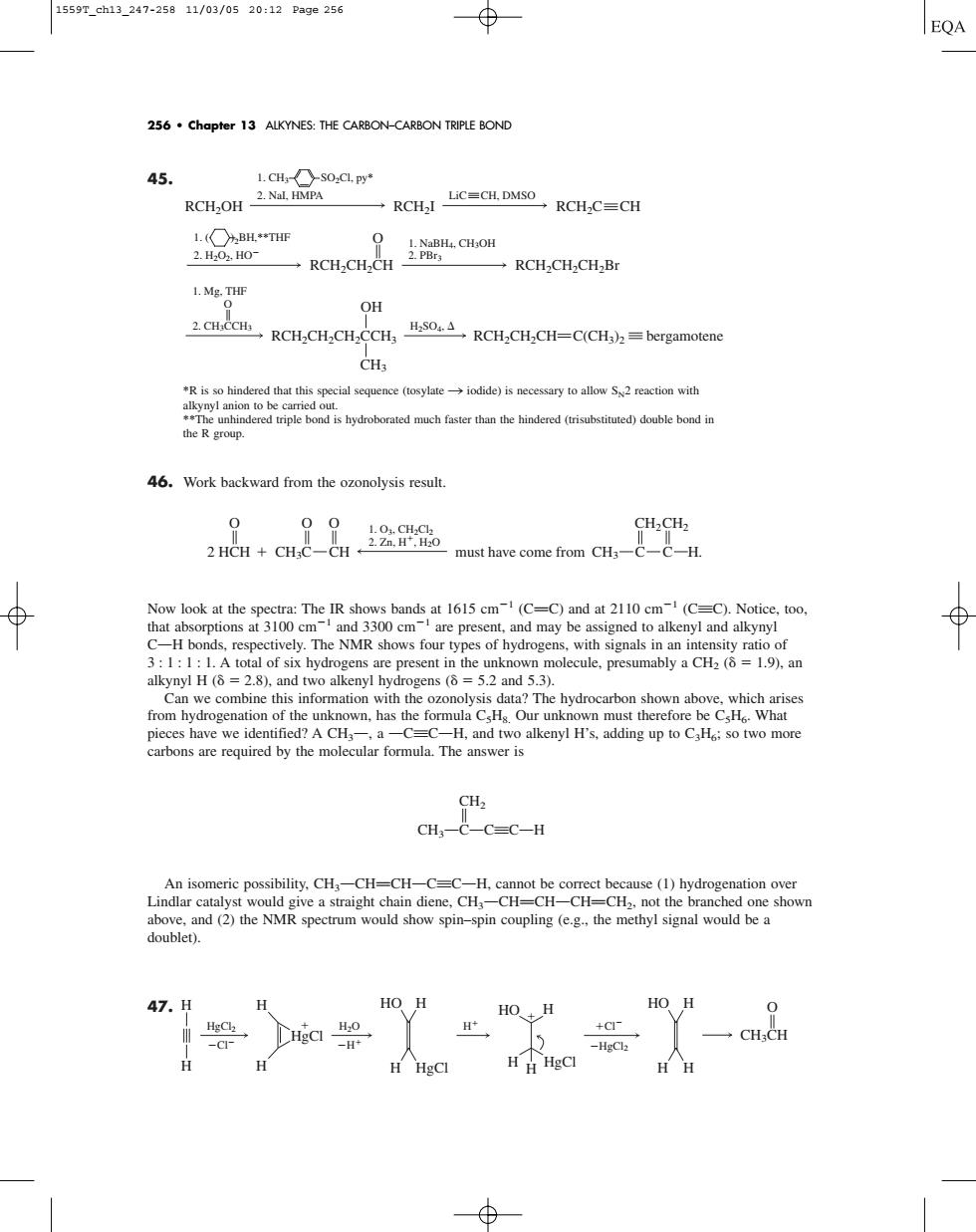正在加载图片...

1559T_ch13_247-25811/03/0520:12Pa9e256 EQA 256.Chapter 13 ALKYNES:THE CARBON-CARBON TRIPLE BOND 45. 一RCH,CH,CH,Br 1.Mg.THF OH 2.CH.CCH RCH,CH.CH-CCH,RCH,CH.CH-C(CH)beramotene CH R is so hindered that this special sequence (tosylate>iodide)is necessary to allow S.2 reaction with 46.Work backward from the ozonolysis result. 000 2 HCH CH3C -CH 2 Now look at the spectra:The IR shows bands at 1615 cm-(C=C)and at 2110 cm-(C=C).Notice,too. are present.and may be a signed to alkenyl and alkynyl CH:-C-C=C-H An isomeric possibility.CH-CH=CH-C=C-H cannot be correct because (1)hydro ation ove Lindlar catalyst would give a straight chain diene.CH -CH=CH-CH=CH,.not the b pranched one shown 47.H HHe 45. *R is so hindered that this special sequence (tosylate n iodide) is necessary to allow SN2 reaction with alkynyl anion to be carried out. **The unhindered triple bond is hydroborated much faster than the hindered (trisubstituted) double bond in the R group. 46. Work backward from the ozonolysis result. Now look at the spectra: The IR shows bands at 1615 cm1 (CPC) and at 2110 cm1 (CqC). Notice, too, that absorptions at 3100 cm1 and 3300 cm1 are present, and may be assigned to alkenyl and alkynyl COH bonds, respectively. The NMR shows four types of hydrogens, with signals in an intensity ratio of 3 : 1 : 1 : 1. A total of six hydrogens are present in the unknown molecule, presumably a CH2 ( 1.9), an alkynyl H ( 2.8), and two alkenyl hydrogens ( 5.2 and 5.3). Can we combine this information with the ozonolysis data? The hydrocarbon shown above, which arises from hydrogenation of the unknown, has the formula C5H8. Our unknown must therefore be C5H6. What pieces have we identified? A CH3O, a OCqCOH, and two alkenyl H’s, adding up to C3H6; so two more carbons are required by the molecular formula. The answer is CH2 B CH3OCOCqCOH An isomeric possibility, CH3OCHPCHOCqCOH, cannot be correct because (1) hydrogenation over Lindlar catalyst would give a straight chain diene, CH3OCHPCHOCHPCH2, not the branched one shown above, and (2) the NMR spectrum would show spin–spin coupling (e.g., the methyl signal would be a doublet). 47. HgCl2 Cl H2O H H H H H H H HgCl HO H HgCl2 Cl O CH3CH H H HO H HgCl H H H HO HgCl O O O 2 HCH CH3C m CH ust have come from 1. O3, CH2Cl2 2. Zn, H, H2O CH3 C H. CH2CH2 C O OH RCH2OH RCH2CH2CH RCH2CH2CH2CCH3 RCH2CH2CH C(CH3)2 CH3 RCH2CH2CH2Br RCH2I RCH2C CH bergamotene 1. CH3 SO2Cl, py* 2. NaI, HMPA LiC CH, DMSO H2SO4,
1. NaBH4, CH3OH 2. PBr3 1. ( )2BH,**THF 2. H2O2, HO 1. Mg, THF 2. CH3CCH3 O 256 • Chapter 13 ALKYNES: THE CARBON–CARBON TRIPLE BOND 1559T_ch13_247-258 11/03/05 20:12 Page 256����������